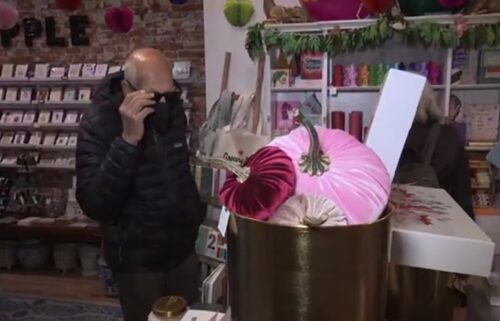China is helping to prop up the Russian economy. Here’s how
By Laura He, CNN
In the year since the Russian invasion of Ukraine, Moscow has been hit by unprecedented Western sanctions and shut out of much of the global economy.
But China, which has declared “no limits” to its friendship with its northern neighbor, has thrown the Kremlin an economic lifeline, tempering the impact of its banishment from the global financial system.
Underscoring the closeness of the relationship, China’s top diplomat Wang Yi met President Vladimir Putin during a visit to Moscow on Wednesday. The Wall Street Journal reported that Chinese President Xi Jinping and Putin could hold a summit in Moscow in April or early May.
Here are three ways in which China, the world’s biggest buyer of commodities and a financial and technological powerhouse, has been propping up the Russian economy:
1. Buying its energy
Western sanctions against Moscow include an embargo on oil sales and a price cap on its crude, denial of access to SWIFT — the international messaging system that enables bank transactions — and the freezing of central bank assets held overseas.
These moves were aimed at weakening Russia’s ability to finance the war.
They’ve had an impact. Russia’s economy slid into recession in 2022, shrinking by 4.5%, according to the most recent estimate by the World Bank.
But Moscow’s fiscal revenues increased, according to the Russian government. That’s mainly thanks to high energy prices and Russia’s efforts to reroute exports to other willing buyers, such as China and India.
“China has supported Russia’s war economically in the sense that it has ramped up trade with Russia, which has weakened Western efforts to cripple Moscow’s military machine,” said Neil Thomas, senior analyst for China and Northeast Asia at Eurasia Group.
“Xi Jinping wants to deepen China’s relationship with an increasingly isolated Russia,” he said, adding that Moscow’s “pariah status” enables Beijing to exert more leverage on it to obtain cheap energy, advanced military technology and diplomatic support for China’s international interests.
Total trade between China and Russia hit a new record high in 2022, up 30% to $190 billion, according to Chinese customs figures. In particular, the energy trade has risen markedly since the onset of the war.
China bought $50.6 billion worth of crude oil from Russia from March to December, up 45% from the same period the previous year. Coal imports surged 54% to $10 billion. Natural gas purchases including pipeline gas and LNG, skyrocketed 155% to $9.6 billion.
It’s a boon for both sides. For Russia, it desperately needs new customers as its fossil fuels are shunned by the West. For China, now focused on getting its economy out of a slump, is in need of cheap energy to power its huge manufacturing industry.
“For Russia, this partnership is born of desperation,” said Keith Krach, former US Under Secretary of State for Economic growth, Energy and the Environment. “He [Putin] is looking for help wherever he can find it and Xi Jinping is all too willing to prey on Putin’s desperation.”
“As for China, its eagerness to boost Russia is the latest in a series of moves that reveal yet again that Beijing is an irresponsible actor,” Krach told CNN.
The two sides are planning to expand that partnership further, including a deal between Gazprom and the China National Petroleum Corporation to supply more gas to China over the next 25 years.
“With China’s economy opening up in 2023, we can expect a further increase in Russian exports to China, including petroleum and other oil refined products,” said Anna Kireeva, an associate professor at Moscow State Institute of International Relations.
2. Replacing Western suppliers
Other than energy, Russia has also been spending billions on buying machinery, electronics, base metals, vehicles, ships and aircraft from China, as detailed in a US Congressional Research Service report from last May.
“Despite China’s reluctance to lend direct support to Russia’s war, bilateral ties will continue to grow because Beijing is opportunistic,” Thomas said.
“Xi values Putin’s support as [a] strategic ballast against an increasingly hostile United States, but he is interested in Russia primarily because of what it can do for China,” he added.
Russia also needs to find substitutes for its imports from Western markets, such as cars and electronics.
“And here China with its industrial capacity cannot be rivaled by any other major producer,” Kireeva said.
Chinese car brands, including Havel, Chery, and Geely, have seen their market share surge from 10% to 38% in a year following the exit of Western brands, according to the most recent data from Russian research firm Autostat. And that share is likely to grow further this year, it has forecast.
In consumer electronics, Chinese brands accounted for about 40% of the smartphone market at the end of 2021. A year later, they’ve virtually taken over the industry with 95% market share, according to market research firm Counterpoint.
3. Providing an alternative to the US dollar
After some Russian banks were cut off from SWIFT, Moscow has been dropping the dollar for the Chinese yuan.
Russian companies have been using more yuan to facilitate the increased trade with China. Russian banks have also conducted more transactions in yuan to protect them from sanction risks, according to Kireeva.
The yuan’s share of the Russian foreign currency market jumped to 48% by November 2022 from less than 1% in January, according to Russian media, citing the head of the Moscow Exchange.
Russia briefly became the world’s third largest offshore trading hub for the yuan last July, behind Hong Kong and the United Kingdom, according to figures released by SWIFT. Since then, it has remained one of the top six markets for trading yuan — it wasn’t even in the top 15 before the Ukraine war.
Russia’s financial ministry has also doubled the share of yuan reserves the country’s sovereign wealth fund can hold to 60%, after a big chunk of its savings were frozen by international sanctions, according to Reuters.
Finance Minister Anton Siluanov has said that Russia would only buy yuan in 2023 to refill the country’s sovereign wealth fund, Tass reported.
“Of all foreign currencies that the Russian [central] bank had its reserves in, it is only Chinese yuan that was not frozen and remains a ‘friendly’ one,” said Kireeva.
“We are likely to see further de-dollarization of Russia’s foreign trade in general and [an] increasing share of trade in national currencies with all states that are friendly or neutral to Moscow.”
With more yuan reserves, Moscow is able to use the Chinese currency to stabilize the ruble and its financial markets. The ruble has plunged by more than 40% against the euro and the dollar in the past year, and the main Russian stock index has fallen by more than a third.
Last month, Russia’s financial ministry announced it would resume foreign exchange interventions by selling yuan and buying rubles.
However, the relationship is not entirely frictionless.
UnionPay, the Chinese payments system, has reportedly stopped accepting cards issued by Russian banks over fears of international sanctions, according to Russian paper Kommersant.
“Large Chinese businesses are wary about secondary sanctions and are cautious about dealing with the Russian entities under sanctions or with the Russian market in general,” Kireeva said.
— CNN’s Michelle Toh contributed to this report
The-CNN-Wire
™ & © 2023 Cable News Network, Inc., a Warner Bros. Discovery Company. All rights reserved.



